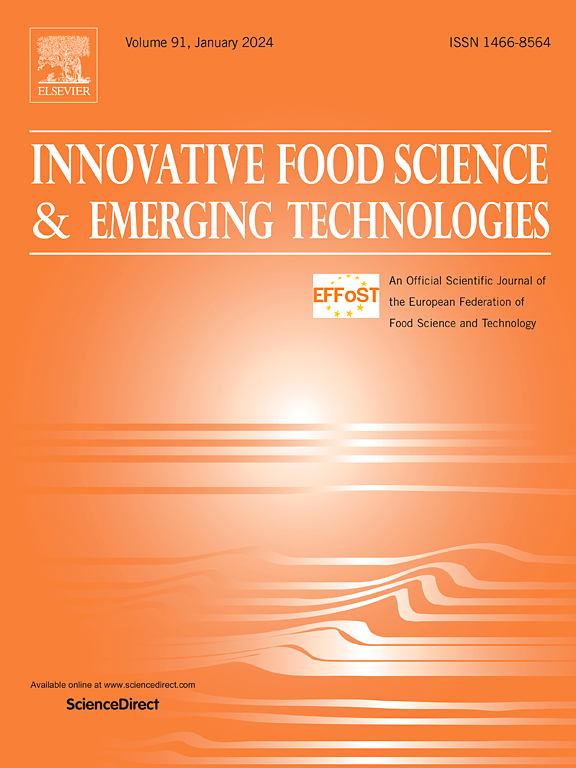Development of chickpea tempeh using Rhizopus oryzae for dysphagia diet: Effect of fermentation time and heat treatment
IF 6.3
1区 农林科学
Q1 FOOD SCIENCE & TECHNOLOGY
Innovative Food Science & Emerging Technologies
Pub Date : 2025-01-31
DOI:10.1016/j.ifset.2025.103940
引用次数: 0
Abstract
Patients with dysphagia must manage their health with an appropriate diet. Chickpea tempeh is a nutritious source of carbohydrates and proteins, but its texture modification is necessary to suit varying severities of dysphagia, according to the International Dysphagia Diet Standardization Initiative (IDDSI) Framework. This study assessed the effects of fermentation time and heat treatment for development of tempeh classified as IDDSI level 6. The physicochemical and structural properties of tempeh were investigated, with a focus on biological changes during fermentation. Tempeh was prepared by grinding chickpeas to particle size of 3.50 ± 0.22 mm and fermenting for 24, 36, 48, 60, and 72 h using Rhizopus oryzae. During fermentation, the biological properties of tempeh changed, resulting in more white mold mycelia (cake) and the release of amylase and protease enzymes. Before cooking, tempeh exhibited increased hardness and brittleness by cake, as well as pH, total soluble solids, and DPPH increased by enzymetic activity. Fungal enzymes and heat treatment (175 °C) changed the rough and aggregated microstructure and molecular structure of chickpeas, as confirmed by scanning electron microscopy and Fourier transform infrared spectroscopy. The texture of cooked tempeh became softer and less brittle by fermentation time, attributed to weakening of cake bonds and enzymatic softening of chickpeas. IDDSI Framework results classified 24 and 36 h fermentation as level 7, and 48, 60, and 72 h fermentation as level 6. Tempeh with modified texture by heat treatment and controlled fermentation time may contribute to the improved health of patients with dysphagia.

利用米根霉制备鹰嘴豆豆豉:发酵时间和热处理的影响
吞咽困难的患者必须通过适当的饮食来管理自己的健康。鹰嘴豆豆豉是碳水化合物和蛋白质的营养来源,但根据国际吞咽困难饮食标准化倡议(IDDSI)框架,鹰嘴豆豆豉的质地需要改变,以适应不同严重程度的吞咽困难。本研究评估了发酵时间和热处理对IDDSI 6级豆豉发育的影响。研究了豆豉的理化性质和结构特性,重点研究了发酵过程中的生物学变化。将鹰嘴豆磨成粒径为3.50±0.22 mm,用米根霉发酵24、36、48、60、72 h制备豆豉。在发酵过程中,豆豉的生物学特性发生了变化,产生了更多的白霉菌菌丝(饼),并释放了淀粉酶和蛋白酶。在蒸煮前,豆豉的硬度和脆度均因饼的作用而增加,pH、可溶性固形物总量和DPPH均因酶活性而增加。通过扫描电镜和傅里叶变换红外光谱证实,真菌酶和热处理(175℃)改变了鹰嘴豆的粗糙和聚集的微观结构和分子结构。熟豆豉的质地随着发酵时间的推移变得更软,更不脆,这是由于饼键的减弱和鹰嘴豆的酶软化。IDDSI框架结果将发酵24和36 h划分为7级,48、60和72 h划分为6级。通过热处理和控制发酵时间来改善口感的豆豉可能有助于改善吞咽困难患者的健康状况。
本文章由计算机程序翻译,如有差异,请以英文原文为准。
求助全文
约1分钟内获得全文
求助全文
来源期刊
CiteScore
12.00
自引率
6.10%
发文量
259
审稿时长
25 days
期刊介绍:
Innovative Food Science and Emerging Technologies (IFSET) aims to provide the highest quality original contributions and few, mainly upon invitation, reviews on and highly innovative developments in food science and emerging food process technologies. The significance of the results either for the science community or for industrial R&D groups must be specified. Papers submitted must be of highest scientific quality and only those advancing current scientific knowledge and understanding or with technical relevance will be considered.

 求助内容:
求助内容: 应助结果提醒方式:
应助结果提醒方式:


